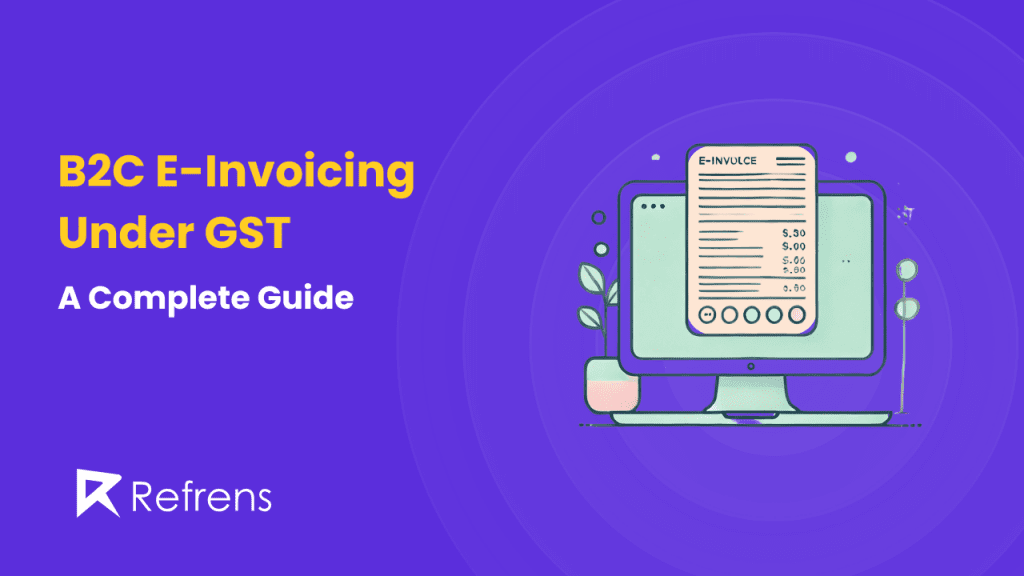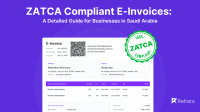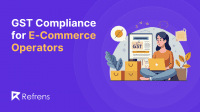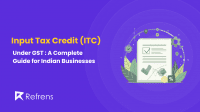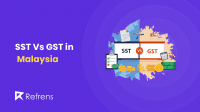Overview of e-Invoicing Under GST
e-Invoicing under the Goods and Services Tax (GST) framework is a system for generating and managing digital invoices that comply with standardized GST requirements. Introduced to streamline tax compliance and improve transparency, e-invoicing under GST involves creating invoices that are directly uploaded to the government’s tax portal. Each e-invoice generated is authenticated and assigned a unique Invoice Reference Number (IRN), allowing tax authorities to track and validate transactions in real-time.
The e-invoicing system applies to businesses that meet certain criteria, often based on turnover thresholds. In India, businesses with annual revenue exceeding INR 10 crore are mandated to use e-invoicing for both B2B (Business-to-Business) and B2C (Business-to-Consumer) transactions. This requirement is expanding globally, with countries like Italy and Saudi Arabia enforcing similar e-invoicing mandates.
The e-invoicing process integrates with the GST Network (GSTN) and is designed to:
- Simplify Tax Filing: e-Invoicing ensures that all invoice data is directly linked to GST returns, making tax filings faster and reducing manual data entry.
- Minimize Errors and Fraud: Automating the invoicing process reduces human errors and limits fraudulent practices by ensuring that each transaction is traceable.
- Enhance Transparency: Real-time visibility of transactions allows tax authorities to monitor business activities more effectively, improving compliance and reducing tax evasion.
e-Invoicing under GST is transforming tax compliance by providing businesses with a more efficient, accurate, and transparent way to manage their invoices.
Introduction to B2C e-Invoicing
What is B2C e-invoicing?
B2C e-invoicing, or Business-to-Consumer electronic invoicing, involves businesses issuing digital invoices to individual consumers. Unlike paper invoices, e-invoices are transmitted electronically, simplifying payment tracking and record-keeping. Common in industries like retail and e-commerce, B2C e-invoicing reduces paperwork and enhances billing accuracy.
Difference Between B2B and B2C e-Invoicing
While B2B e-invoicing involves detailed tax and approval processes between businesses, B2C e-invoicing is simpler and aimed directly at consumers with fewer documentation needs. The complexity and compliance requirements are generally lower in B2C transactions.
| Aspects | B2B e-Invoicing | B2C e-Invoicing |
|---|---|---|
| Invoice Recipient | Other Businesses (partners, suppliers) | Individual consumers |
| Invoice Complexity | High (detailed tax info, multiple approvals) | Lower complexity |
| Usage | Common in supply chains, wholesale transactions | Common in retail, e-commerce, utility bills |
| Tax Compliance | Requires detailed tax Documents | Simpler tax compliance, less detailed |
| Approval Processes | Multiple layers (finance, procurements, etc) | Usually, no approvals are needed from the consumer |
Importance of B2C e-Invoicing
- Transparency: Ensures accurate transaction records and reduces tax evasion.
- Efficiency: Automates processes, reducing errors and speeding up payments.
- Tax Compliance: Helps governments track taxable income, reducing evasion.
- Sustainability: Cuts down paper usage, promoting eco-friendly practices.
- Customer Experience: Provides faster, more convenient invoicing and payment options.
- Security: Ensures data protection through encrypted and secure platforms.
B2C e-invoicing enhances transparency, reduces costs, improves customer experience, and helps businesses comply with tax regulations. As more regions mandate digital invoicing, its role in modern commerce will only grow.
Objectives of B2C e-Invoicing
1. Reduce Tax Evasion
B2C e-invoicing ensures all transactions are accurately recorded and reported to tax authorities, minimizing the risk of underreporting and manipulation. The system creates a transparent, real-time log of sales, making it easier for authorities to detect discrepancies and reduce tax evasion.
2. Boost Compliance
E-invoicing brings businesses into a standardized framework for reporting sales to consumers, simplifying tax reporting and ensuring better oversight. This uniform process helps businesses avoid non-compliance penalties and keeps reporting consistent across various sectors.
3. Enhance Business Efficiency
Automation through e-invoicing streamlines invoicing processes, reducing manual errors and speeding up reconciliation. Integrated with accounting systems, e-invoicing enables real-time updates and improved cash flow management, making operations more efficient.
4. Sustainability
By eliminating paper-based invoicing, B2C e-invoicing reduces resource consumption and waste. Going paperless lowers the carbon footprint of businesses, contributing to sustainability goals while enhancing operational efficiency.
B2C e-Invoicing Implementation Date
B2C e-invoicing is a major step towards improving transparency, compliance, and efficiency in consumer transactions. The implementation timeline was announced after the 54th GST Council Meeting on September 9, 2024, outlining a phased approach to ensure a smooth transition for businesses.
Pilot Program Launch
A pilot program will be launched in early 2025, focusing on select sectors and states. This trial phase will help businesses and tax authorities test the system and address any challenges. Feedback from this phase will be essential to fine-tune the system before broader implementation.
Full-Scale Rollout
Following a successful pilot, full-scale implementation is expected by mid-2026. This gradual rollout ensures businesses have enough time to adapt to the new system, integrate digital invoicing technologies, and train their teams. By the completion of the rollout, all B2C transactions will be brought under the e-invoicing framework.
Preparation for Businesses
Businesses are advised to start preparing for B2C e-invoicing by upgrading their invoicing systems, adopting digital invoicing practices, and staying informed about compliance requirements. Early adoption will ensure a smooth transition when the full implementation begins.
This phased approach allows the government to ensure that B2C e-invoicing is implemented efficiently, bringing long-term benefits such as reduced tax evasion, enhanced business efficiency, and improved tax reporting.
Applicability of e-Invoicing in B2C
Sectors Covered
B2C e-invoicing will initially apply to industries like retail, e-commerce, quick commerce, OIDAR (Online Information Database Access and Retrieval) services, and online gaming. These sectors, with high volumes of consumer transactions, are well-suited for early adoption, helping to enhance transparency and streamline tax reporting.
Turnover Thresholds
In the initial phase, businesses with an annual turnover exceeding Rs. 500 crore will be required to comply first. These larger businesses are expected to lead the implementation, as they have the infrastructure and resources necessary to integrate e-invoicing efficiently.
Voluntary Basis
Currently, B2C e-invoicing is voluntary for select sectors during the pilot phase. This approach allows businesses to gradually transition to the system while providing feedback for further refinements before mandatory enforcement.
This phased rollout, starting with larger businesses in key sectors, ensures a manageable and effective implementation of B2C e-invoicing.
How B2C e-Invoicing Works
Businesses use their existing billing or ERP systems to generate tax invoices for B2C transactions. These invoices include all necessary details like items, taxes, and prices.
2. Reporting to the Invoice Registration Portal (IRP)
The invoice is uploaded to the Invoice Registration Portal (IRP), where it is verified for accuracy and compliance with e-invoicing standards. The IRP also forwards validated invoices to the GST system for tax reporting and, if necessary, to the e-way bill portal.
3. IRN & QR Code Generation
After verification, the IRP generates a unique Invoice Reference Number (IRN) and a QR code for each invoice. The QR code contains key details, allowing quick verification of the invoice’s authenticity.
4. Issuing the e-Invoice
The authenticated invoice, with the IRN and QR code, is sent to the consumer via email, SMS, or a physical copy. The QR code scan enables easy verification by the consumer or authorities.
5. Record Keeping
While the IRP validates the invoice, it doesn’t store it permanently. Businesses must retain copies in their systems for future reference and audits.
This process enhances transparency, reduces manual errors, simplifies tax compliance, and integrates seamlessly with government systems for smoother reporting.
Requirements for e-Invoicing in B2C
To ensure compliance and smooth implementation of B2C e-invoicing, businesses must meet several key requirements:
1. Dynamic QR Code
Businesses with an annual turnover of Rs. 500 crore or more must include a dynamic QR code on B2C invoices. This QR code holds essential invoice details like the Invoice Reference Number (IRN) and total value, allowing for easy verification by consumers and authorities.
2. Data Reporting
Invoices must be reported to the Invoice Registration Portal (IRP) using the JSON format based on the INV-01 schema. This ensures consistency and allows the IRP to validate and authenticate invoices efficiently. Once verified, the IRP generates the IRN and QR code, which are added to the final invoice.
3. Integration with Billing Systems
Businesses need to integrate their ERP systems, billing systems, or POS machines with the e-invoicing framework. This integration ensures automated, real-time invoice generation and reporting, reducing manual errors and improving operational efficiency.
These requirements are critical for ensuring accurate reporting, compliance, and seamless invoicing operations as B2C e-invoicing rolls out.
Benefits of e-Invoicing for B2C
B2C e-invoicing provides several key advantages that improve business operations, transparency, and compliance:
1. Standardization Across Industries
It ensures uniformity in invoicing practices, simplifying tax reporting and reducing discrepancies across different sectors.
2. Reduction in Fraudulent Invoices
By requiring authentication through the Invoice Registration Portal (IRP), e-invoicing significantly reduces the chances of invoice manipulation or duplication, helping prevent tax evasion.
3. Increased Transparency
E-invoicing boosts transparency by providing consumers with authenticated invoices, building trust, and ensuring that transactions are legitimate and accurately recorded.
4. Accurate Reporting
Real-time reporting ensures all sales are recorded, reducing the risk of under-reporting in GSTR-1 returns and helping businesses maintain tax compliance.
5. Operational Efficiency
By automating the invoicing process, businesses can reduce manual errors, speed up operations, and improve overall efficiency through integration with billing and ERP systems.
These benefits make B2C e-invoicing a powerful tool for enhancing transparency, preventing fraud, and improving business efficiency.
Challenges of B2C e-Invoicing
While B2C e-invoicing brings many benefits, businesses face several key challenges:
1. IT Infrastructure Requirements
Businesses need to invest in robust IT systems capable of handling real-time invoicing, especially those with high transaction volumes. Upgrading or integrating systems can be costly, particularly for smaller companies.
2. Staff Training
Sales, IT, and accounting teams will need the training to adapt to new processes, particularly handling dynamic QR codes and ensuring compliance with e-invoicing requirements.
3. Data Management
Managing large volumes of data from multiple sources, such as ERP and POS systems, can be complex for businesses, especially in sectors like retail. Effective data management is critical for accurate and compliant invoicing.
4. Real-Time Invoice Generation
Ensuring invoices are generated, authenticated, and issued to consumers within a limited timeframe (e.g., 48 hours) requires smooth integration between billing systems and the IRP.
Addressing these challenges will help businesses transition smoothly to B2C e-invoicing and fully leverage its benefits.
Conclusion
B2C e-invoicing is more than a move toward digitalization—it’s a crucial step for businesses to enhance transparency, comply with tax regulations, and improve operational efficiency.
The gradual rollout provides businesses with enough time to adapt, while the benefits—such as faster invoicing, reduced fraud, and better tax compliance—make it a valuable investment.
By integrating tools like Refrens for seamless e-invoicing and compliance, businesses can stay ahead of the curve and operate more efficiently. As the future of invoicing becomes increasingly digital, adopting B2C e-invoicing early will ensure businesses are well-prepared for the shift.
Frequently Asked Questions (FAQs)
1. What is B2C e-invoicing?
B2C e-invoicing refers to the electronic invoicing system for businesses selling goods or services to individual consumers under GST. It requires generating an invoice with a dynamic QR code for transactions but does not involve direct reporting to the GST system.
2. Is e-invoicing mandatory for B2C?
Currently, B2C e-invoicing is not mandatory. It is being introduced voluntarily in select sectors as part of a pilot program, with full implementation expected in the future.
3. What are the requirements for B2C e-invoicing?
B2C e-invoicing requires businesses to generate a dynamic QR code for invoices and integrate their systems with the Invoice Registration Portal (IRP) for real-time authentication.
4. How does B2C e-Invoicing differ from B2B e-Invoicing?
In B2B e-invoicing, invoices are directly reported to the GST system for authentication, while B2C e-invoicing focuses on generating QR codes without mandatory reporting to tax authorities.
5. What is the limit for B2C e-invoicing?
As of now, there is no official turnover limit for mandatory B2C e-invoicing. However, the pilot phase is expected to cover businesses with turnovers above Rs. 500 crore.

